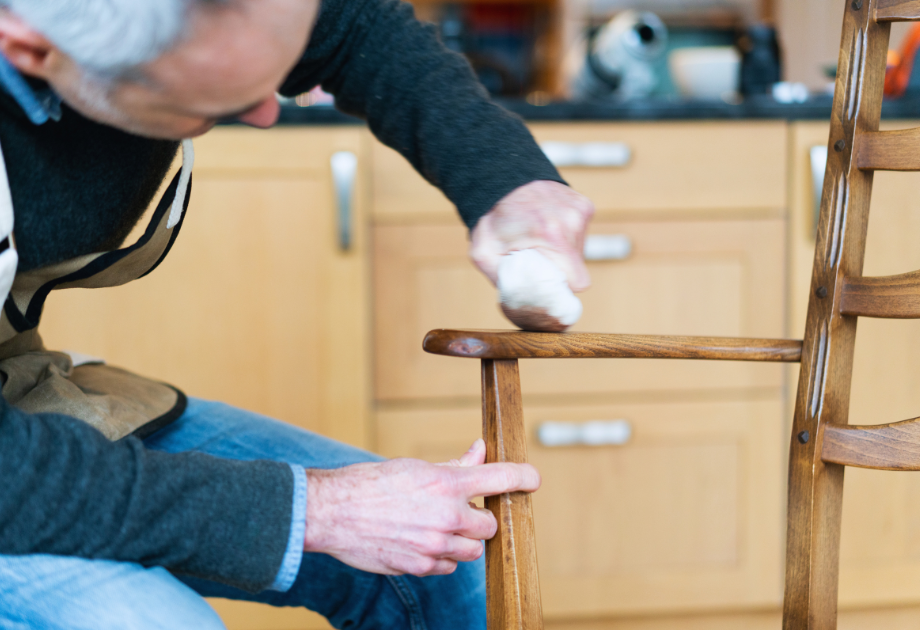How to Maintain Your Restored Antique Wood Furniture
.png)
How to Maintain Your Restored Antique Wood Furniture
Restoring your treasured antique furniture is just the first step in keeping these pieces as beautiful as the day they were crafted. Now that your furniture has been brought back to life, it’s time to consider how best to care for it, so it stays in excellent condition for generations to come.
In this guide, I’ll walk you through easy, practical steps to preserve the charm of your vintage furniture refurbished work. With a few simple habits, you’ll keep those pieces looking and feeling great for years to come.
Regular Dusting and Cleaning: Keeping It Simple
Nothing is more timeless than a well-cared-for piece of furniture, and regular cleaning is essential to preserving its charm. Antique furniture maintenance begins with gentle, regular dusting to protect the finish and avoid unnecessary wear.
Use a Soft, Dry Cloth for Dusting
Choose a soft microfiber or lamb’s wool duster for the best results. These options are gentle on finishes and effective at removing dust without causing scratches or leaving residues. A weekly dusting is enough to keep your antique furniture restoration results looking as beautiful as ever.
Avoid Water and Harsh Cleaners
Water can seep into the wood grain, causing damage over time, and all-purpose cleaners often contain harsh chemicals that can strip finishes. Instead, I recommend Milsek Furniture Polish and Wood Cleaner for a safe and effective clean. It’s the same trusted product I use during restorations to clean while protecting finishes. Stick to this product and dry dusting to maintain the results of your antique furniture care.

Polishing and Conditioning: Keep the Shine Alive
To bring out the luster in your mid-century antique furniture, it’s important to polish it carefully. Let’s discuss when to use oil or wax and how often, so you can maintain that shine without causing damage.
Wax or Oil: What’s Right for Your Piece?
When it comes to antique furniture care, knowing the right polish to use makes a big difference. Generally, wax offers a protective finish, while oil helps condition the wood. If your piece has been waxed, stick with that for polishing—otherwise, use oil only if the wood needs hydration. Not sure which is best? Reach out for some advice from a professional antique furniture restoration service!
How Often Should You Polish?
Polishing too often can lead to buildup, so aim for a light polish once or twice a year, depending on your piece’s needs. Less is more when it comes to keeping antique preservation simple yet effective.
Protecting Your Furniture from Sunlight and Heat
Sunlight and heat can be tough on wood furniture, causing finishes to fade and wood to warp over time. Here’s how you can prevent these natural elements from undoing your restoration work.
Choose the Right Placement
Where you place your furniture can make a world of difference. Keep items away from direct sunlight and heat sources, like radiators, to protect them from fading or warping. Consider installing UV-resistant window films, which can block harmful rays and keep your vintage mid century furniture looking vibrant.
Rotate Pieces to Even Out Wear
Rotate your furniture periodically to balance light exposure and wear. This practice helps prevent one side from becoming faded while the other remains pristine, preserving that classic look.

Watch for Seasonal Changes: Humidity and Temperature Control
Humidity and temperature fluctuations can spell trouble for antique furniture. Wood is sensitive to changes, and maintaining consistent levels will help protect your restored pieces.
Maintain Stable Humidity Levels
Antiques do best in environments where humidity is kept between 35% and 65%. Investing in a humidifier or dehumidifier can help maintain stability, which is especially important for high-end furniture in antique preservation.
Avoid Extreme Temperature Changes
Wood expands and contracts with temperature changes, which can lead to cracks and other damage. Try to avoid placing your furniture in areas that experience frequent shifts in temperature to keep your antique furniture restoration looking flawless.
Handling and Use: How to Prevent Everyday Damage
How you interact with your furniture daily can have a lasting impact on its condition. These small precautions will keep your furniture safe from everyday wear and tear.
Use Coasters and Pads to Prevent Scratches
Always use coasters, placemats, and felt pads to prevent scratches on your furniture. These small habits make a big difference, especially for highly-used surfaces like tabletops, protecting your antique furniture maintenance efforts in the long run.
Lift, Don’t Drag
When moving pieces, be sure to lift them rather than dragging them across the floor. This small step keeps joints secure, preventing unnecessary stress on the frame and preserving the piece’s structural integrity.
Preserving Your Restored Antique Furniture for Generations
With these simple yet effective steps, you’ll be able to enjoy your beautifully restored antique furniture for years to come. Taking time to care for these pieces ensures they remain a cherished part of your home, capturing the timeless beauty of vintage furniture refurbish work. Remember, the best care combines consistency with thoughtful attention—and if you ever have questions, Old School Craftsman is always here to guide you in protecting your family’s treasured heirlooms.
Reach out to Old School Craftsman today!
Follow us on Facebook, Instagram, and Pinterest for updates from our latest projects and discussions on historic homes.
Happy with the difference Old School Craftsman made on your home? Leave us a five-star review!
